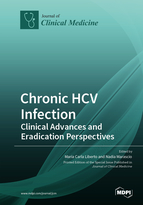Chronic HCV Infection: Clinical Advances and Eradication Perspectives
A special issue of Journal of Clinical Medicine (ISSN 2077-0383). This special issue belongs to the section "Infectious Diseases".
Deadline for manuscript submissions: closed (31 October 2021) | Viewed by 14665
Special Issue Editors
Interests: pathogen-host interaction; basic and clinical virology; HCV epidemiology and drug-resistance; diagnostic methods
Interests: clinical virology; viral pathogenesis; HCV drug-resistance; classic and molecular epidemiology; microbiome and metagenome analysis; infectious diseases; microbiology; HBV; HDV; HEV; HIV; antibiotic resistance
Special Issues, Collections and Topics in MDPI journals
Special Issue Information
Dear Colleagues,
Hepatitis C virus (HCV) chronic infection can determine liver fibrosis, cirrhosis and hepatocellular carcinoma, as well as several extra-hepatic manifestations (i.e., mixed cryoglobulinemia, metabolic syndrome, kidney disease, etc.). HCV infection is asymptomatic until severe stages of disease, thus screening policy in the general population and in specific risk categories is necessary to allow for timely intervention. Despite a high sustained virological response by direct-acting antiviral drugs, a limited percentage of treated subject failed therapy according to resistance associated substitution carried on viral isolates and comorbidities in infected patients. Therefore, tailored therapy is required to cure HCV infection. Failure to comply with these conditions may impair success of HCV eradication expected by 2030. This Special Issue aims to discuss eradication perspectives related to therapy efficacy in patients with chronic diseases, developments in diagnostic procedures and improvements in screening policy. We would like to invite original research, short communications, review and viewpoints. We look forward to your submissions.
Prof. Dr. Maria Carla Liberto
Dr. Nadia Marascio
Guest Editors
Manuscript Submission Information
Manuscripts should be submitted online at www.mdpi.com by registering and logging in to this website. Once you are registered, click here to go to the submission form. Manuscripts can be submitted until the deadline. All submissions that pass pre-check are peer-reviewed. Accepted papers will be published continuously in the journal (as soon as accepted) and will be listed together on the special issue website. Research articles, review articles as well as short communications are invited. For planned papers, a title and short abstract (about 100 words) can be sent to the Editorial Office for announcement on this website.
Submitted manuscripts should not have been published previously, nor be under consideration for publication elsewhere (except conference proceedings papers). All manuscripts are thoroughly refereed through a single-blind peer-review process. A guide for authors and other relevant information for submission of manuscripts is available on the Instructions for Authors page. Journal of Clinical Medicine is an international peer-reviewed open access semimonthly journal published by MDPI.
Please visit the Instructions for Authors page before submitting a manuscript. The Article Processing Charge (APC) for publication in this open access journal is 2600 CHF (Swiss Francs). Submitted papers should be well formatted and use good English. Authors may use MDPI's English editing service prior to publication or during author revisions.
Keywords
- Hepatitis C Virus (HCV)
- Chronic infection
- Treatment efficacy
- Direct Acting Antivirals (DAA)
- Resistance Associated Substitution (RAS)
- Epidemiology
- Screening policy
- Eradication of infection
- Hepatic diseases
- Extra-hepatic manifestations








